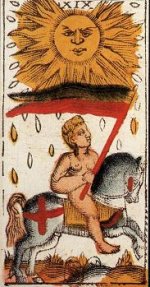Kiama
Whilst researching theurgy for my MA I came across an article called "Riders in the Sky - Cavalier Gods and Theurgic Salvation in the Second Century AD"by Sarah Iles Johnston, in which she says:
The Chaldean Oracles fragment in question reads:
We know that Hermetic magicians and members of the Golden Dawn, as well as other similar occultists were interested in the Chaldean Oracles - many of them studied them. Could it be that Arthur Edward Waite studied them, and placed the imagery of a theurgic epiphany in the Sun card?
Thuergy during this time was heavily based in Middle Platonism and Neoplatonism, in which the sun ruled over the noetic or celestial realm, (which the magician aimed to have his soul move into) whilst the moon rules over the earth. This, linked with the imagery of a theurgic epiphany, seems apt for the Sun card in the Tarot - the naked child riding a horse which is white (shining more brightly than light). Is this an explanation for what I previously considered to be rather strange imagery in the Sun card?
For those of you who wish to read the full article, you can find it in Classical Philology vol. 87, no. 4, October 1992, pp. 303-321.
Blessings,
Kiama
The epiphany in question is that of a divinity who will manifest himself to the theurgist as a child on a horse, according to the Chaldean Oracles frag. 146.
The Chaldean Oracles fragment in question reads:
Having spoken these things, you will behold
either a fire leaping skittishly like a child over the aery waves;
or an unformed fire from which a voice emerges;
or a rich light that whirs around the field in a spiral.
But [it is also possible] that you will see a horse flashing more brightly than light,
either also a fiery child mounted on the swift back of the horse,
covered with gold or naked;
or even a child shooting arrows, upright upon the horse's back.
We know that Hermetic magicians and members of the Golden Dawn, as well as other similar occultists were interested in the Chaldean Oracles - many of them studied them. Could it be that Arthur Edward Waite studied them, and placed the imagery of a theurgic epiphany in the Sun card?
Thuergy during this time was heavily based in Middle Platonism and Neoplatonism, in which the sun ruled over the noetic or celestial realm, (which the magician aimed to have his soul move into) whilst the moon rules over the earth. This, linked with the imagery of a theurgic epiphany, seems apt for the Sun card in the Tarot - the naked child riding a horse which is white (shining more brightly than light). Is this an explanation for what I previously considered to be rather strange imagery in the Sun card?
For those of you who wish to read the full article, you can find it in Classical Philology vol. 87, no. 4, October 1992, pp. 303-321.
Blessings,
Kiama


